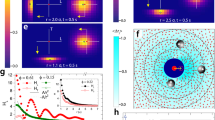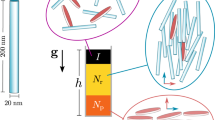Abstract
In a numerical study, Bowen and Sharif1 purported to capture attractive interactions between like-charged colloidal particles by solving the nonlinear Poisson–Boltzmann equation around two particles in a pore. We are unable to replicate their results, in accord with recent proofs2,3 showing that this equation cannot produce attractions between like-charged particles. Our calculations reveal only repulsive interactions between confined particles, indicating that the cause for anomalous colloidal multibody interactions is still unknown.
Similar content being viewed by others
Main
Colloidal interactions are critical to a variety of processes, including bacterial adhesion4, the flow of colloidal dispersions5, and the self-assembly of nanoparticles to form optoelectronic devices6. Electrostatic interactions between colloidal particles are fairly well described by the Derjaguin– Landau–Vervey–Overbeek (DLVO) theory7,8. However, direct measurement has revealed qualitative departures from this theory in multibody, low-salt situations9,10. Theoretical work11,12,13,14,15 has tried to describe the attractions between like-charged colloidal particles.
Like Bowen and Sharif, we solved the nonlinear Poisson–Boltzmann equation in an axisymmetric geometry. We performed finite-element simulations using FIDAP software with successive grid refinement to check the convergence of our results. A fine grid is needed to obtain accurate results, and integrating the stress tensor over the midplane between particles and over a parallel plane far from the particles allows us to obtain faster convergence than was achieved by Bowen and Sharif, although we checked our results using their technique of integrating over the sphere surface. Our typical grid contains 100,000 nodes, including 220 on the surface of the sphere, twice as many as Bowen and Sharif. We also used regular grid spacings near the important boundaries to minimize numerical noise.
We found that colloidal particles in a pore are repulsive at all distances — indeed, the pore has only a small mitigating effect on the repulsions relative to isolated particles (Fig. 1). Using the same parameters as Bowen and Sharif, the gap between the particle surface and the pore surface is approximately eight Debye lengths, so only a small perturbative effect was expected. (The Debye length, κ−1, is inversely proportional to the square root of the salt concentration, and represents the decay length of screened electrostatic interactions.)
Particles are either isolated, confined in a pore of radius 9.12 κ−1, or confined in a pore of radius 2.185 κ−1. For all simulations, the zeta potentials on the pore wall and on the surfaces of the particles are 128.5 and 77.1 mV, respectively, and κa=1.185, where the particle radius a=325 nm. The salt is monovalent, the temperature is 298 K, and the relative permittivity is 78. Parameter values are the same as in ref. 1.
Multibody effects are known to mitigate repulsions between cylinders in planar slits11, but significant effects are not seen until the confining walls are within the range of 1–2 Debye lengths. Increasing the confinement of the pore geometry by reducing the pore wall–particle gap to one Debye length results in significantly smaller repulsive interactions than for isolated spheres (Fig. 1), but there are still no attractions.
Our results are in keeping with proofs2,3 that the nonlinear Poisson–Boltzmann equation cannot produce attractive forces for the conditions simulated here and in general for confined or unconfined colloids in a system with mirror symmetry and overall electroneutrality. Together with these proofs, our results indicate that there may be an insidious error in the computations of Bowen and Sharif. In addition, the proofs2,3 show that solutions of the mean-field nonlinear Poisson–Boltzmann equation cannot explain electrostatic interactions between like-charged colloidal particles9, so new physical theories need to be developed.
References
Bowen, W. R. & Sharif, A. O. Nature 393, 663–665 (1998); correction Nature 402, 841 (1999).
Neu, J. C. Phys. Rev. Lett. 82, 1072–1074 (1999).
Sader, J. E. & Chan, D. Y. C. J. Colloid Interface Sci. 213, 268–269 (1999).
Razatos, A. P., Ong, Y. L., Sharma, M. M. & Georgiou, G. Proc. Natl Acad. Sci. USA 95, 11059–11064 (1998).
Chen, L.-B., Ackerson, B. J. & Zukoski, C. F. J. Rheol. 38, 193–216 (1994).
Joannopoulos, J. D., Villeneuve, P. R. & Fan, S. Nature 386, 143–149 (1997).
Derjaguin, B. V. & Landau, L. Acta Physiochim. 14, 633–662 (1941).
Verwey, E. J. W. & Overbeek, J. T. G. Theory of the Stability of Lyophobic Colloids: The Interaction of Sol Particles Having an Electric Double Layer (Elsevier, New York, 1948).
Crocker, J. C. & Grier, D. G. Phys. Rev. Lett. 77, 1897–1900 (1996).
Larsen, A. E. & Grier, D. G. Nature 385, 230–233 (1997).
Ospeck, M. & Fraden, S. J. Chem. Phys. 109, 9166–9171 (1998).
Kwon, G. W., Won, Y. S. & Yoon, B. J. J. Colloid Interface Sci. 205, 423–432 (1998).
Stevens, M. J., Falk, M. L. & Robbins, M. O. J. Chem. Phys. 104, 5209–5219 (1996).
Tehver, R., Ancilotto, F., Toigo, F., Koplik, J. & Banavar, J. R. Phys. Rev. E 59, R1335–R1338 (1999).
Goulding, D. & Hansen, J.-P. Europhys. Lett. 46, 407–413 (1999).
Author information
Authors and Affiliations
Rights and permissions
About this article
Cite this article
Gray, J., Chiang, B. & Bonnecaze, R. Origin of anomalous multibody interactions. Nature 402, 750 (1999). https://doi.org/10.1038/45445
Issue Date:
DOI: https://doi.org/10.1038/45445
This article is cited by
-
Colloidal interactions: contact limiting laws, double-layer dissociation, and "non-DLVO" (Derjaguin–Landau–Verwey–Overbeek) forces
Colloid and Polymer Science (2003)
Comments
By submitting a comment you agree to abide by our Terms and Community Guidelines. If you find something abusive or that does not comply with our terms or guidelines please flag it as inappropriate.




